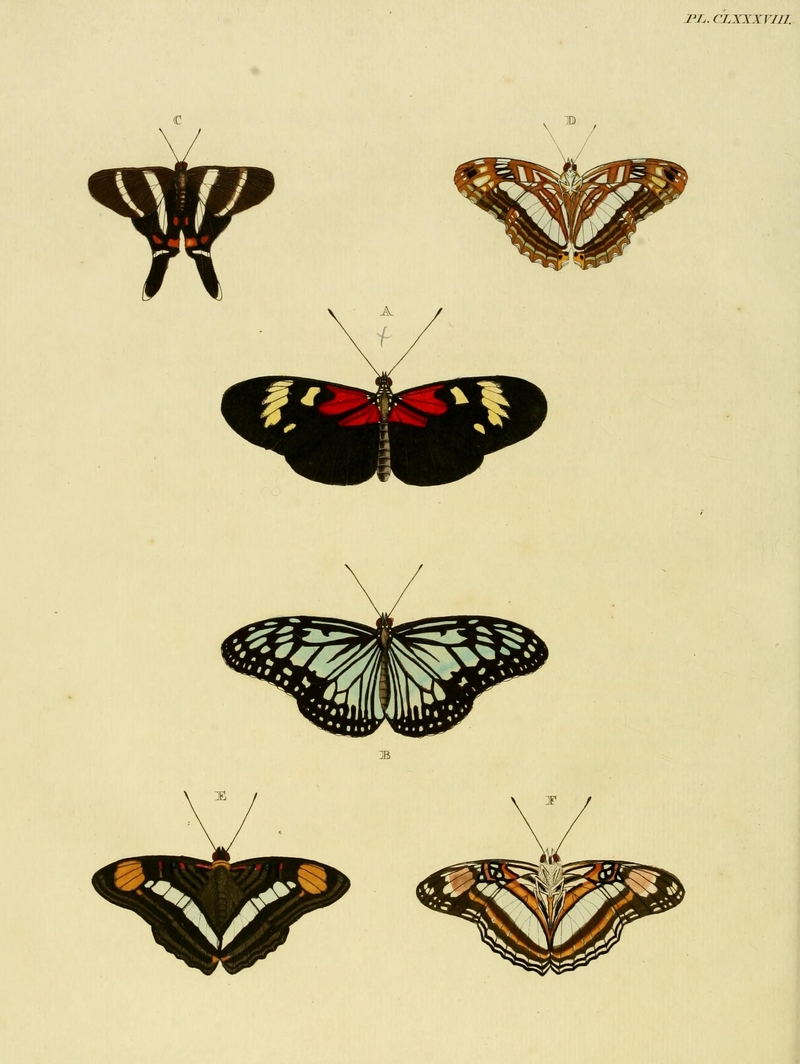|
| Query: Butterflies | Result: 556th of 2945 | |
Papilio cybele = Heliconius melpomene meriana (common postman), Papilio juventa = Ideopsis juventa (wood nymph), Papilio periander = Rhetus periander (Periander metalmark butterfly), Papilio basilea = Adelpha iphiclus iphiclus (Iphiclus sister), Papilio basilea = Papilio iphicla = Adelpha iphiclus (Iphiclus sister)
| Subject: | Papilio cybele = Heliconius melpomene meriana (common postman), Papilio juventa = Ideopsis juventa (wood nymph), Papilio periander = Rhetus periander (Periander metalmark butterfly), Papilio basilea = Adelpha iphiclus iphiclus (Iphiclus sister), Papilio basilea = Papilio iphicla = Adelpha iphiclus (Iphiclus sister)
| | Poster: | Wiki Photos (---@---.---)
| |

| Resolution: 2461x3273
File Size: 1319193 Bytes
Upload Date: 2023:04:24 15:24:41
|
Plate CLXXXVIII
A: "(Papilio) Cybele" ( = Heliconius melpomene meriana), In register spelled as "CYBILE".
B: "(Papilio) Juventa" ( = Ideopsis juventa, iconotype?).
C: "(Papilio) Periander" ( = Rhetus periander, iconotype?).
D: "(Papilio) Basilea" ( = Adelpha iphiclus).
E, F: "(Papilio) Iphicla" ( = Adelpha iphiclus iphiclus).
Date 1779
Source Volume 2 of "De uitlandsche kapellen: voorkomende in de drie waereld-deelen Asia, Africa en America = Papillons exotiques des trois parties du monde, l'Asie, l'Afrique et l'Amérique" https://archive.org/stream/deuitlandschekap02cram#page/n329/mode/2up
Author Pieter Cramer (1721 - 1776) and Caspar Stoll (between 1725 and 1730 - 1791)
Source: https://commons.wikimedia.org/wiki/File:CramerAndStoll-uitlandsche_kapellen_vol._2-_plate_188.jpg
Fig. A: Papilio cybele = Heliconius melpomene meriana (subsp. postman butterfly, common postman)
Heliconius melpomene, the postman butterfly, common postman or simply postman, is a brightly colored butterfly found throughout Central and South America, especially on the slopes of the Andes mountains. The postman butterfly is predominately black with either red or yellow stripes across the forewings. The postman butterfly has large long wings (35–39 mm). It is poisonous and the red patterns on its wings are an example of aposematism.
Fig.B: Papilio juventa = Ideopsis juventa (wood nymph)
Ideopsis juventa, the wood nymph, gray glassy tiger or grey glassy tiger, is a species of nymphalid butterfly in the Danainae subfamily. It is found in Southeast Asia. This butterfly is dark gray or black with two rows of circular white dots along the margins of its wings and elongated white patches closer to the body. The elongated white patches appear to radiate from the thorax.
Fig. C: Papilio periander = Rhetus periander (Periander metalmark)
Rhetus periander, the Periander metalmark or variable beautymark, is a butterfly of the family Riodinidae. It is found in most of Central America and South America, ranging from Mexico to Brazil and Argentina. Rhetus periander is usually found singly or in very low numbers, in the vicinity of streams or rivers. It can be also be found along tracks through primary or disturbed rainforest or cloudforest habitats.
Fig. D: Papilio basilea = Adelpha iphiclus (Iphiclus sister)
Fig. E, F: Papilio iphicla = Adelpha iphiclus iphiclus (subsp. Iphiclus sister)
Adelpha iphiclus, the Iphiclus sister, is a butterfly of the family Nymphalidae. It is found in the tropics and sub-tropics of Central and South America. The subspecies Adelpha iphiclus iphiclus can be seen in Mexico to western Colombia, Venezuela, Ecuador, Peru, Bolivia, Surinam, Brazil: Amazon, Mato Grosso. |
^o^
Animal Pictures Archive for smart phones
^o^
|
|